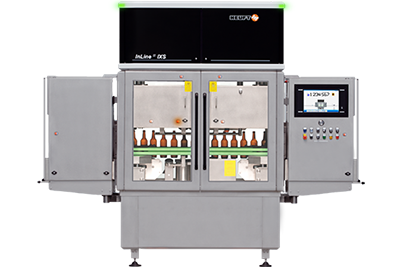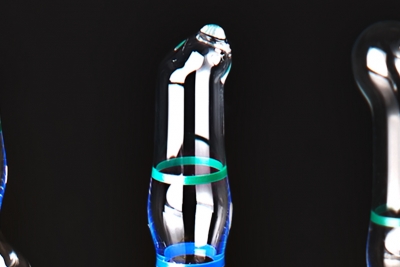Excluding inclusions!
Inclusions in glass containers threaten the product safety of drinks, food and pharmaceuticals. And in addition the efficiency and productivity of complete filling lines. That is why it is best to remove the primary packaging material in question before the filling process – with powerful empty glass container inspectors from HEUFT.
The end of line system has fulfilled its task: it has clearly identified the foreign object on the base using pulsed X-ray technology and accurately rejected the freshly filled small food jar. Impressive. After all the object is just the size of a pinhead. And it is not even in the paste-like product. In fact it is an inclusion in the glass. That makes no different to the full container inspectors of the HEUFT eXaminer series: they reliably detect such faults in both cases.
Which is a good thing too. Because foreign objects have no business to be in either the product or the packaging material. And air, ceramic, stone or metal inclusions which can occur during the manufacture of the container are nothing more than minute foreign objects in the glass. They hold potential dangers not to be underestimated in view of the trend towards primary packaging material which is increasingly lighter and with thinner walls: they result in stress, cracks and at worst glass breakage. In this case sharp-edged chipping can be detrimental to the product and seriously endanger its safety.
Simply no stress!
Because glass containers with inclusions are less stable when they are placed under mechanical or thermal stress. And that is often the case throughout the whole process chain. Bumpy transport from the glassworks to the filling line and from there to the retail sector, impact pressure and collisions in lines without HEUFT conveyor control systems, high temperatures in the rinser, during the hot filling, pasteurisation and sterilisation – the sources of danger are many and varied.
Metal inclusions, in particular, have extremely high expansion coefficients when things get hot. For example glass breakage can occur in the autoclave as a result. This not only impairs product safety due to the intrusion of dangerous foreign objects but also the efficiency and productivity of the complete line: it stops each time until fragments and splinters have been completely removed from the machine and the conveyors. It is clear that this adversely affects the production times and the output.
Simply no waste!
The latter also suffers when inclusions are only first identified during the full container inspection. Because the finished, actually perfect product ends up in the bin then. It is also wasted as pointlessly as the packaging to which the closure and labels have already been applied. Those who wish exclude all this should decide on an empty glass container inspector which already finds inclusions before the filling process and removes the containers in question from the production flow in good time.
The systems of the HEUFT InLine series carry this out with maximum precision. The smart optical examination covers the full volume of each individual empty container. Foreign objects in the glass are detected just as reliably in the course of this as those in the inner area of the packaging. The HEUFT InLine II IXS provides even more detection accuracy. Because in addition the system of the new generation is equipped with unique X-ray flashes. Thus minute glass splinters on the base of the container and the finest hairline cracks in the glass are still found besides inclusions even before the filling process.
The return on investment is achieved quickly: product and material waste is therefore also prevented in the same way as costly recall actions and product liability cases. At the same time there are less standstills and considerably more efficiency and output when filling drinks, food and pharmaceuticals.




